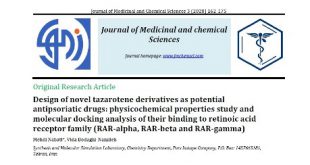The molecular structure and the stability parameters of 99mTc-MDP
Medronate, commonly known as methylene diphosphonate or MDP, is the smallest bisphosphonates, recognized as a family of drugs used in treatment of various bone diseases.
Bisphosphonates are the structural analogs of native pyrophosphate with a P-C-P backbone instead of P-O-P.
The structural resemblance results in MDP’s chelation to calcium and the consequent high affinity for osteocalcin receptors.
Osteocalcin is the most prominent non-collagenous protein existing in bone matrix and is produced by osteoblasts. Osteocalcin has a high affinity for calcium ions and thus is believed to be responsible for MDP’s transport by osteoblasts to the bone.
It was hypothesized that MDP could accumulate in bone via adsorption to the surface of hydroxyapatite existent in the bone or absorbing into hydroxyapatite crystalline structure. Other factors were also considered for MDP’s binding and interaction with the bone namely, accumulation of MDP at areas of active bone metabolism.
The bone-seeking potential of bisphosphonates lead to consideration of utilizing MDP radiolabelled with Technetium-99m for skeletal imaging.
Technetium-99m emits gamma ray with the energy of 140 keV has a 6 h half-life which makes 99mTc-MDP a great diagnostic agent in bone scintigraphy, using single photon emission computed tomography (SPECT).
۹۹mTc-MDP specifically binds to and accumulates in bone while delineating areas of altered osteogenesis through gamma emission.
Moreover, 99mTc-MDP has a rapid clearance as well as high urinary excretion which results in a higher contrast between the soft tissue and the bone.
It is therefore valuable in early diagnosis and identification of the extent of skeletal diseases as well as locating bone metastases.
As the chemistry of this mechanism is quite complicated, no certain theory described the biological behavior of the 99mTc-MDP. This predicament stems from the vague and incomplete information about the manner in which MDP binds and interacts with technetium-99m. Furthermore, the exact structural mode of interaction between 99mTc-MDP and osteocalcin receptors is yet not to be understood. In addition, the physiochemical factors affecting the stability and reactivity of 99mTc-MDP kit is still wildly understudied.
In 2020, Dr. Mehdi Nabati and his coworkers did various experiments on this radiopharmaceutical. Their work is divided into two sections. The experimental section relates to the different formulations of the medronate cold kit that were made in various conditions. The results show that after 2 months, the radiochemical yield and stability was accomplished. Storing the kits at room temperature instead of refrigerator temperature (5 °C) changed the color from white lyophilized powder to yellow; however the stability of all yellow kits was constant as white kits. The theoretical section was to identify the precise molecular structures of the nuclear medicine. The quantum mechanical computations showed two most stable molecular structures for this radiopharmaceutical. The global reactivity indices indicated the high stability of the molecular structures and their tendency to interact with the biomolecules. The docking results revealed that, the main interactions between the molecular structures and osteocalcon receptor were associated with the residues Leu 25, Asn 26, Asp 30, Cys 29, Tyr 42, Tyr 46, and Phe 38.
For more information about the molecular structure and the stability parameters of 99mTc-MDP (technetium-99m methylene diphosphonate) cold kit, please read the following article:
 Iranian Chemist شیمیدان ایرانی
Iranian Chemist شیمیدان ایرانی






Wow, attractive site. Thnx …